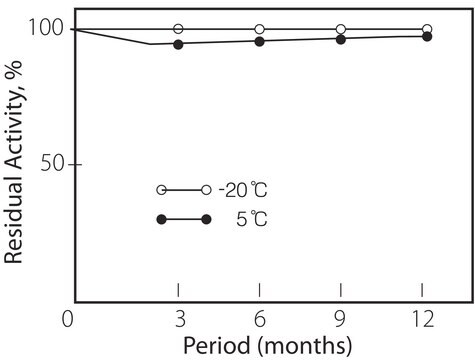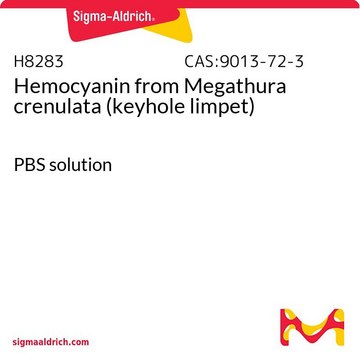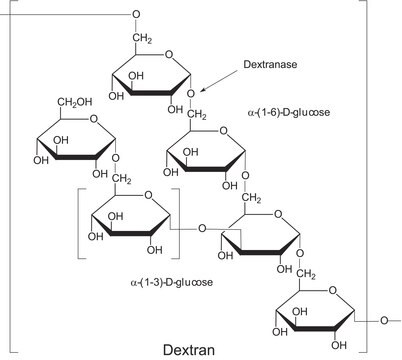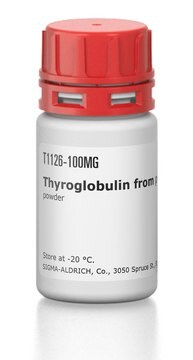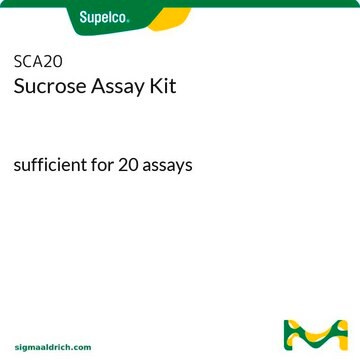I0408
Invertase Glycoprotein Standard
BioReagent, from Saccharomyces cerevisiae
Synonym(s):
Invertase from baker’s yeast (S. cerevisiae), β-D-Fructofuranosidase, β-D-Fructofuranoside fructohydrolase, Saccharase
Sign Into View Organizational & Contract Pricing
All Photos(1)
About This Item
Recommended Products
biological source
Saccharomyces cerevisiae
Quality Level
product line
BioReagent
form
lyophilized powder
mol wt
60 kDa
concentration
≥0.5 mg/vial protein (E1%/280)
storage temp.
2-8°C
Looking for similar products? Visit Product Comparison Guide
Application
Invertase Glycoprotein Standard has been used:
- to generate N-linked glycan library
- as a negative control to study the binding of lectins to high mannose structures
- for sample pre-treatment in proteomic analyses to study drug-induced toxic epidermal necrolysis
The Invertase Glycoprotein Standard can be used to demonstrate N-glycosylation using PNGase F with both in-solution and in-gel procedures. The extent of deglycosylation can be assessed by mobility shift on SDS-PAGE gels.
Used in the production of confectionary foods and artificial honey.
Biochem/physiol Actions
Invertase hydrolyzes sucrose into glucose and fructose yielding a colorless product, unlike acid hydrolysis which produces colored products.
Other Notes
Invertase is an enzyme that catalyses the hydrolysis of sucrose into fructose and glucose. Invertase Glycoprotein Standard is the periplasmic (glycosylated form, external invertase) with 50% of its mass as polymannan. Since yeast can provide an alternative system for protein glycosylation that is similar to mammalian systems, periplasmic invertase is often used as a model for the study of the function of oligosaccharides in glycoproteins and for studies on glycoprotein biosynthesis.
signalword
Danger
hcodes
pcodes
Hazard Classifications
Resp. Sens. 1
Storage Class
10 - Combustible liquids
wgk_germany
WGK 3
ppe
Eyeshields, Gloves, type N95 (US)
Choose from one of the most recent versions:
Already Own This Product?
Find documentation for the products that you have recently purchased in the Document Library.
Customers Also Viewed
Proteomic kinetic analysis of blister fluid and serum in a patient with drug-induced toxic epidermal necrolysis. A comparison with skin immunohistochemistry
Paquet P, et al.
Current Drug Safety (2012)
A lectin affinity workflow targeting glycosite-specific, cancer-related carbohydrate structures in trypsin-digested human plasma
Analytical biochemistry (2011)
Glycan characterization of the NIST RM monoclonal antibody using a total analytical solution: From sample preparation to data analysis
Hilliard M, et al.
MAbs (2017)
Rachel Morissette et al.
Bioscience reports, 32(6), 577-586 (2012-09-04)
In eukaryotes, GPI (glycosylphosphatidylinositol) lipid anchoring of proteins is an abundant post-translational modification. The attachment of the GPI anchor is mediated by GPI-T (GPI transamidase), a multimeric, membrane-bound enzyme located in the ER (endoplasmic reticulum). Upon modification, GPI-anchored proteins enter
Nayan J Sarma et al.
Nucleus (Austin, Tex.), 3(6), 508-515 (2012-10-11)
Transcriptional regulation is a complex process that requires the integrated action of many multi-protein complexes. The way in which a living cell coordinates the action of these complexes in time and space is still poorly understood. Recent work has shown
Our team of scientists has experience in all areas of research including Life Science, Material Science, Chemical Synthesis, Chromatography, Analytical and many others.
Contact Technical Service

